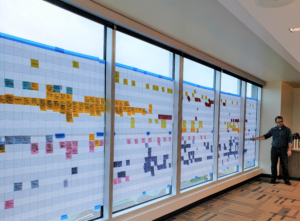02.24.2020
The Importance of Scheduling Quality Control and Commissioning
 One important industry-related topic that doesn’t always get the attention it deserves is how and when to go about scheduling quality control and commissioning activities. These activities are found most frequently within data centers, industrial facilities and healthcare facilities, but can apply to any project.
One important industry-related topic that doesn’t always get the attention it deserves is how and when to go about scheduling quality control and commissioning activities. These activities are found most frequently within data centers, industrial facilities and healthcare facilities, but can apply to any project.
In general construction, it’s typical to receive a project schedule from an architect, general contractor or even the end-user client. On some projects we provide input on the schedule through pull planning meetings, where trade partners are able to give valuable input. These schedules all have milestone dates that end with the turnover of the building or the process to the end-user. This method has been battle tested in general construction and works well to deliver buildings as scheduled.
Why doesn’t this process work for quality control and commissioning resources? Typically, schedules are built with two dates in mind: the start date of construction and the finish date for turnover to the client. In between is filled with activities for construction. So what happens when the quality control and commissioning teams need weeks or months of time to turn over assets to the client? Generally, there is a standard process that each end user uses for quality control and commissioning. This process, when performed correctly, may take three weeks between an asset being 100% completed or installed and being turned over to the client. Most construction schedules don’t allow for that amount of time before project turnover.
At Faith Technologies, we know the importance of focusing on quality control and commissioning tasks from day one, while building an entire project schedule. This is extremely important for mechanical-electrical-plumbing (MEP) trade partners that will be relied upon heavily during the quality control and commissioning phases of the project. Understanding the level of detail and time required for these activities will be the difference between a successful project and a project that never ends. End-user clients and general contractors that have been successful throughout the commissioning phases of the project are those who have figured out how to extract useful information from their trade partners in order to build the best schedule. Building construction schedules in reverse, starting from the end with client turnover and working back to the start of construction, gives the quality control and commissioning teams the ability to influence decisions based on factual dates and timelines for the teams to complete their scopes of work.
All teams on a project need to work together in order to deliver best-in-class buildings or projects for their clients. Without the install team, the commissioning team wouldn’t have equipment to work on, and without the commissioning team, the installation team wouldn’t be able to turn over a fully functional product to the client.
The most successful projects are completed when the commissioning team is at the beginning of the planning process, before any dirt is moved.
If you enjoyed this blog article, please subscribe to stay up to date on the latest industry news from our experts at Faith Technologies.



